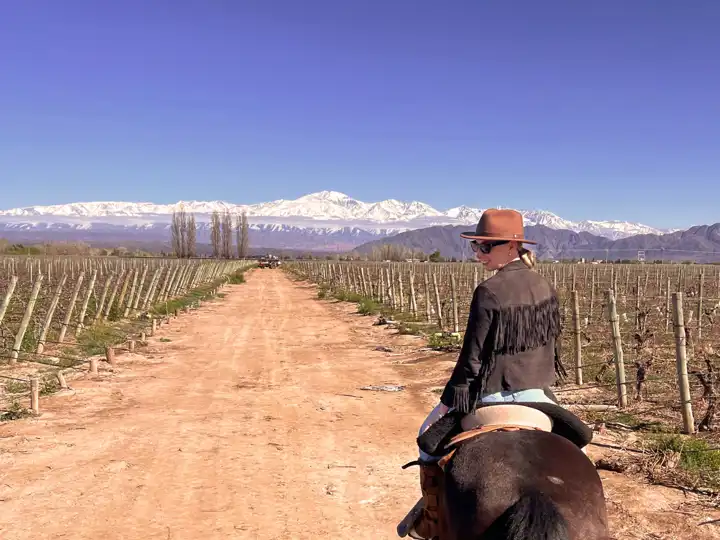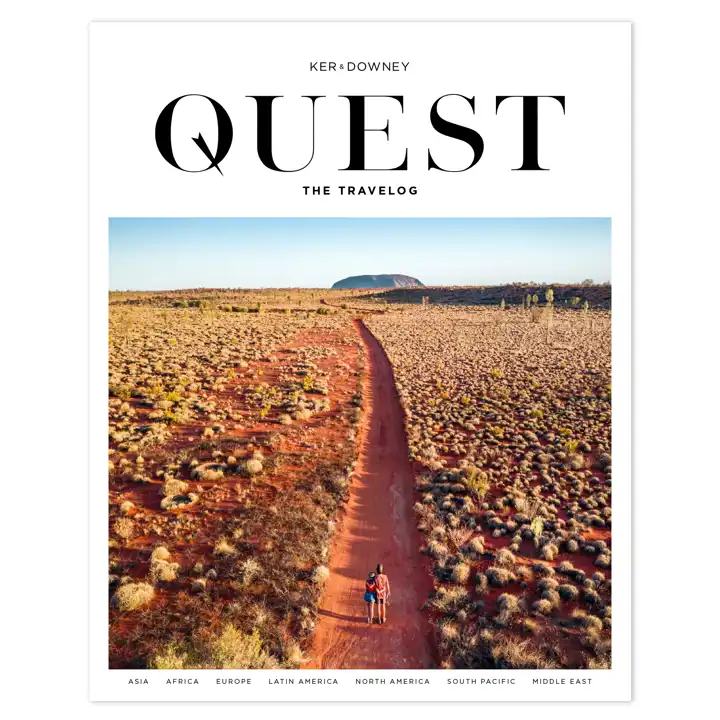Vistas Among The Vines
As Seen in Quest Magazine
Landing in the early morning hours, I find myself standing in the winding lines of immigration, hoping to glimpse the sunrise coming over the Andes. My fellow travelers and I had that delirious look on our faces, the one you make after being on a plane for more than eight hours, still in the same clothes you put on a day earlier, in your familiar home, in your everyday life, in your usual surroundings. The same ones you are wearing now but in a completely foreign, unfamiliar, and brand-new place. I have been displaced, transported, and a bit disoriented, but yes, that feeling is so sweet. Now I know the adventure has started.
Where I once had been in the sweltering summer heat of Texas, I now stand behind people holding their ski boots. Welcome to the wintery September of Santiago, Chile. Chile merely asks you to "choose your adventure." And while the majority selected the extremely thrilling call of the mountains, I am here to get a taste of the softer, slower, sweeter side of Chile. After clearing immigration, I climb into a car on my way to the Santa Rita Winery, where my first taste of Chile and its wines await.
On my hour-long drive out of the city, I finally come face to face with those towering Andes gods overlooking the city. Santiago and most of the wine-fertile land of the Central Valley sit between the Andes and the Chilean Coastal Mountain Range. However, these mountains aren’t silent watchers; they are very much alive. They like to rumble and talk. They don't want their presence to only be seen but to be felt.

My guide explains to me that Chile is one of the most tectonically active countries in the world and earthquakes are a part of daily life. Because of the constant earthquakes, most buildings had to be rebuilt over time. The modern city of Santiago is engineered to weather any number registering on the Richter scale.
Maipo Valley, Chile
As we drive onto the expansive Santa Rita Winery, I realize what makes it a rare gem. The vibrant, red-painted adobe of the historically preserved 19th-century hacienda is one of few remaining in the country. As I enter the estate, I’m immersed in a charming, bygone era. Hotel Casa Real on the Santa Rita Winery was once the summer home of the winery's founder, Don Domingo Fernandez Concha. The property has been beautifully restored with only 16 rooms to maintain the 1880s splendor with intimate family accents complemented by all the modern luxuries.
I walk through the salons to my room, passing the family portraits and personal mementos, and I feel as though I am playing a role in a period piece of this family's life on a grand estate. Excited for the next scene, I stroll through the estate's private grounds and park, as if this was all mine, and head to the winery.
The Santa Rita Winery is located in one of the country's most famous and oldest wine regions, Maipo, known for producing high-quality red wines. The Cabernet Sauvignon, Merlot, Syrah, and especially the Carménère have gained international recognition, becoming a great national pride for Chile. The Carménère is considered a “lost grape rediscovered" and holds a unique place in the country's wine identity. Originally from Bordeaux, the grape nearly went extinct and disappeared from France before making a resurgence in Chile during the mid-1990s. Now, Chile has become the global home of Carménère.

I spend my afternoon learning about the specific characteristics of Santa Rita’s wine collection. With a stroll through the vines, then a visit to marvel at the massive vats crushing and fermenting grapes, I find my way into the dark, cool cellars where the barrels are aged. There is a candlelit table and a spread of wines waiting to be tasted. With a glance at the color, a swirl of the glass, a waft of the aroma, and finally, a taste paired with a bite of cheese or fruit, I become acquainted with each flavor profile and type. By the end of the experience, it is no surprise that the bold and complex profile with hints of red fruit and spice of the Carménère has won me over.
The night is spent indulging in more wine during a sundowner, and I’m off to bed with a full belly after a five-course pairing meal that immediately drops me into a deep, heavy sleep.
Casablanca Valley, Chile
The next day, I explore the metropolis of Santiago, followed by a walk through the bright street art of its coastal neighbor, Valparaíso, before making my way to the next winery in the Rosario Valley near Chile’s Casablanca wine region. Another preserved historic estate, Matetic Winery and the La Casona Hotel might as well be the yellow sister to Santa Rita. The 16-room beautifully renovated and restored 18th-century estate on the winery gleams bright with its golden adobe. Each room faces the center gardens, with back patios opening directly to the vines.
What makes Matetic unique from most other wineries in the region, however, is its biodynamic winemaking practices. Taking things a step further than an organic winery, Matetic's process incorporates alignment with lunar cycles. It uses native plants and animals to create a closed-loop, self-sustaining ecosystem that creates the purest, freshest wines, allowing the full expression to come through without any outside influences.

I get the full biodynamic experience while here. Starting with a bike ride to the winery, I stroll with the ducks, chickens, geese, and goats as they work diligently, carefully tending to the vines as natural pesticide and fertilizer. We plant bull horns filled with minerals into the soil next to the plants as a natural compost. We tour the processing facilities before making our way to a tasting where, holding a single glass of wine, I am filled with appreciation and awe at all the efforts from so many individuals and processes going into this moment for me to enjoy. I savor and give thanks to this amalgam of the old and new ways to produce and enjoy wine.

Pro Tip! If flying out of Santiago on your way home, carve out a night or two to stay at a nearby wine estate instead of in the city. It's the perfect way to end any trip through South America. -Elizabeth Frels
Mendoza, Argentina
I eventually find myself towering above the grand Andes mountains, flying across the range and landing in the wine capital of South America: Mendoza, Argentina. Upon landing, I feel as if I have landed in Heaven on Earth. The snowcapped Andes mountains set the backdrop for miles and miles of vineyards. This sun-soaked paradise, with its clear skies and crisp mountain air, is a wine lover’s dream. The earth here, rich and fertile, produces some of the world’s finest Malbec, whose bold and rich flavors match the region itself. Mendoza isn’t just about wine – it’s about a lifestyle, where the spirit of the land meets the artistry of winemakers, creating a masterpiece of flavors and experiences. Mendoza immediately welcomes me with warmth, beauty, and a taste of Argentina itself.
I arrive at my little slice of heaven for the next few nights at Cavas Wine Lodge. The grand white Spanish-styled colonial estate greets me as I walk under a canopy of vines to my private villa. In peak season, you can pick grapes straight from the vine and enjoy a fresh treat as you meander through the beautiful property. A fire is set in a pit on my villa’s roof as I pour myself a glass of wine and nestle in to read a book, the rows and rows of vines before me extending to the mountains' base.

The following day, I begin exploring the different wineries of the Luján de Cuyo Valley. Luján de Cuyo is famous for its Malbec, a grape synonymous with Argentine wine. The region's unique combination of altitude, terroir, and climate allows the Malbec grape to thrive, yielding wines with intense color, bold flavors, and smooth tannins. After three different tastings, I fully acquaint myself with the delight of the Malbec and, to my surprise, find myself relishing an up-and-coming wine in the Argentine repertoire, the Cabernet Franc. The fruit-forward taste and softer tannins have me imagining warm nights sipping from the glass while preparing a home-cooked meal to pair and complement perfectly.

"I feel the power of my horse beneath me, and the beauty of the land and the artistry of the moment have me fully immersed in the Argentine wine country. It is the perfect way to end the adventure."
Back at Cavas, an exciting experience awaits me as my gaucho brings two Argentine horses for us to gallop and explore. As we race between rows of vines, getting an up-close-and-personal interaction with the plants that will one day produce fine wines, I feel so connected to the pristine land. The mountains in the background halo the serene landscape. I feel the power of my horse beneath me, and the beauty of the land and the artistry of the moment have me fully immersed in the Argentine wine country. It is the perfect way to end the adventure.
As the next day leads onwards to Buenos Aires where I will make my way back home, I promise myself that I will return.
Ready to relax, indulge, and heighten your senses in South America? Contact a Ker & Downey travel designer to make the most out of your time among the vines.

Quest Magazine
Dedicated to the experiential style of Ker & Downey travel, QUEST Magazine features eye-opening content that focuses on unforgettable experience, unheard-of destinations, and the very best our world has to offer. Each issue is packed with insider information, what's new in the world of travel, and editorial pieces that focus on our global culture, philanthropy, and transformative travel.
Read The Spring 2025 IssueSee What We Are Up To
Subscribe to our Weekly Newsletter for Travel Tips and Insider Guides for Planning your Next Journey!
